MNG93003 Industry Research Project: Analyzing Staff Turnover at Ausnew
VerifiedAdded on 2023/06/11
|29
|9395
|347
Report
AI Summary
This report investigates the factors contributing to high staff turnover at Ausnew Company, a hospitality group established in 2017. The research employs primary data collected through interviews and surveys with employees and managers, alongside secondary data from existing literature. Key areas explored include the role of human resource management, continuous professional development, leadership, and HR policies in employee retention. The findings highlight the need for effective strategies to address turnover, considering aspects like training, incentives, and work environment. The report also acknowledges limitations and suggests directions for future research. Desklib provides access to similar solved assignments and resources for students.
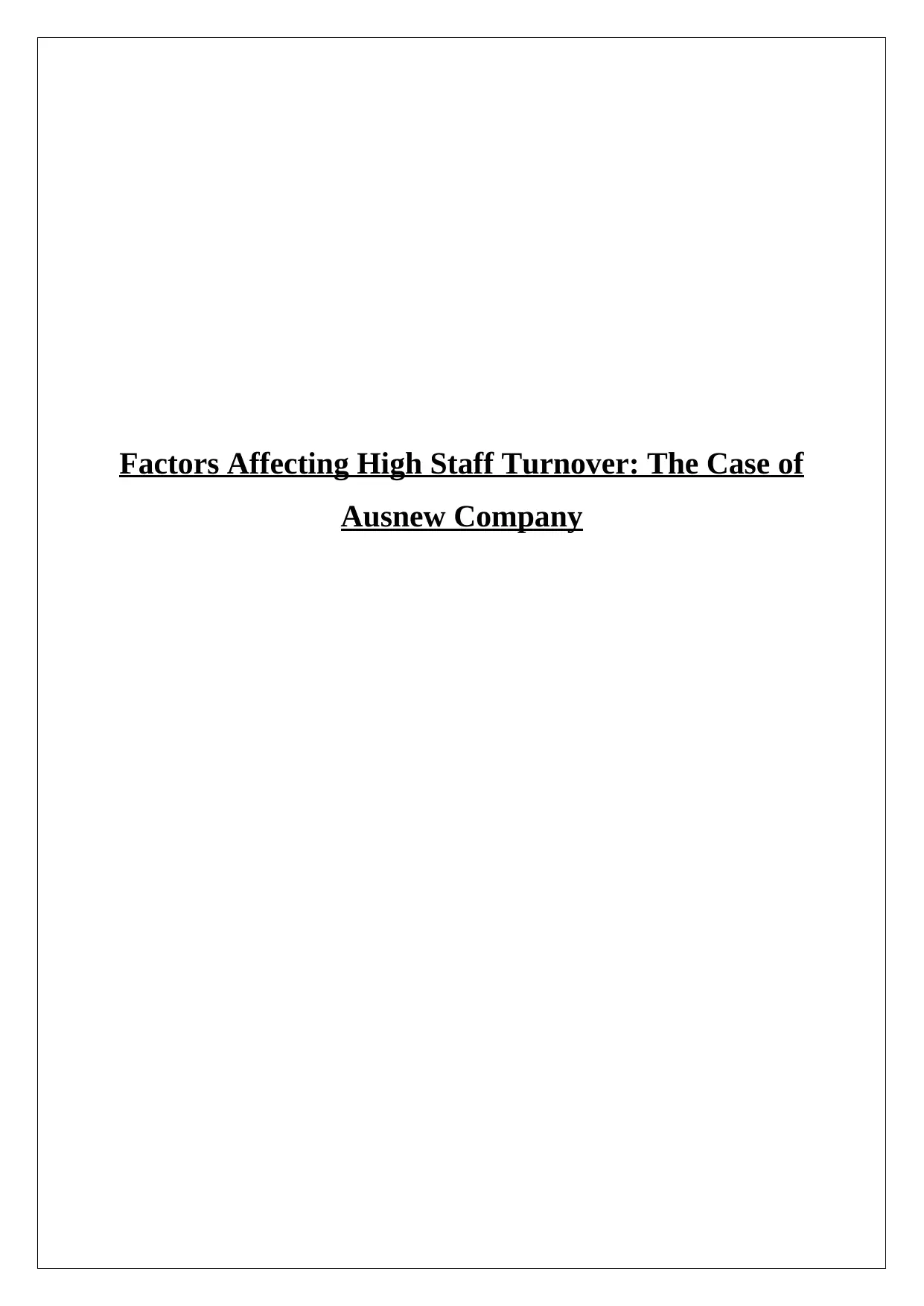
Factors Affecting High Staff Turnover: The Case of
Ausnew Company
Ausnew Company
Paraphrase This Document
Need a fresh take? Get an instant paraphrase of this document with our AI Paraphraser
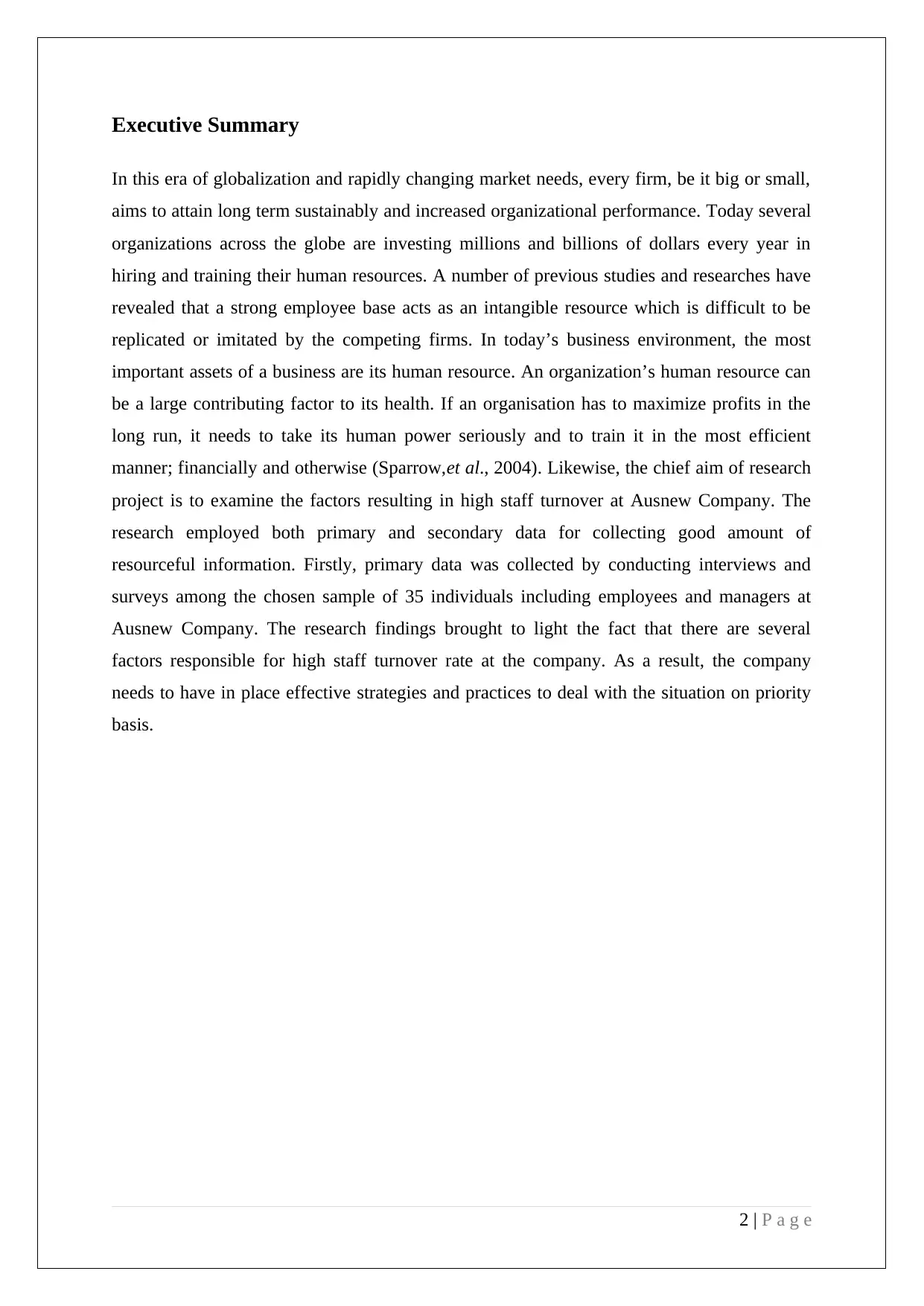
Executive Summary
In this era of globalization and rapidly changing market needs, every firm, be it big or small,
aims to attain long term sustainably and increased organizational performance. Today several
organizations across the globe are investing millions and billions of dollars every year in
hiring and training their human resources. A number of previous studies and researches have
revealed that a strong employee base acts as an intangible resource which is difficult to be
replicated or imitated by the competing firms. In today’s business environment, the most
important assets of a business are its human resource. An organization’s human resource can
be a large contributing factor to its health. If an organisation has to maximize profits in the
long run, it needs to take its human power seriously and to train it in the most efficient
manner; financially and otherwise (Sparrow,et al., 2004). Likewise, the chief aim of research
project is to examine the factors resulting in high staff turnover at Ausnew Company. The
research employed both primary and secondary data for collecting good amount of
resourceful information. Firstly, primary data was collected by conducting interviews and
surveys among the chosen sample of 35 individuals including employees and managers at
Ausnew Company. The research findings brought to light the fact that there are several
factors responsible for high staff turnover rate at the company. As a result, the company
needs to have in place effective strategies and practices to deal with the situation on priority
basis.
2 | P a g e
In this era of globalization and rapidly changing market needs, every firm, be it big or small,
aims to attain long term sustainably and increased organizational performance. Today several
organizations across the globe are investing millions and billions of dollars every year in
hiring and training their human resources. A number of previous studies and researches have
revealed that a strong employee base acts as an intangible resource which is difficult to be
replicated or imitated by the competing firms. In today’s business environment, the most
important assets of a business are its human resource. An organization’s human resource can
be a large contributing factor to its health. If an organisation has to maximize profits in the
long run, it needs to take its human power seriously and to train it in the most efficient
manner; financially and otherwise (Sparrow,et al., 2004). Likewise, the chief aim of research
project is to examine the factors resulting in high staff turnover at Ausnew Company. The
research employed both primary and secondary data for collecting good amount of
resourceful information. Firstly, primary data was collected by conducting interviews and
surveys among the chosen sample of 35 individuals including employees and managers at
Ausnew Company. The research findings brought to light the fact that there are several
factors responsible for high staff turnover rate at the company. As a result, the company
needs to have in place effective strategies and practices to deal with the situation on priority
basis.
2 | P a g e
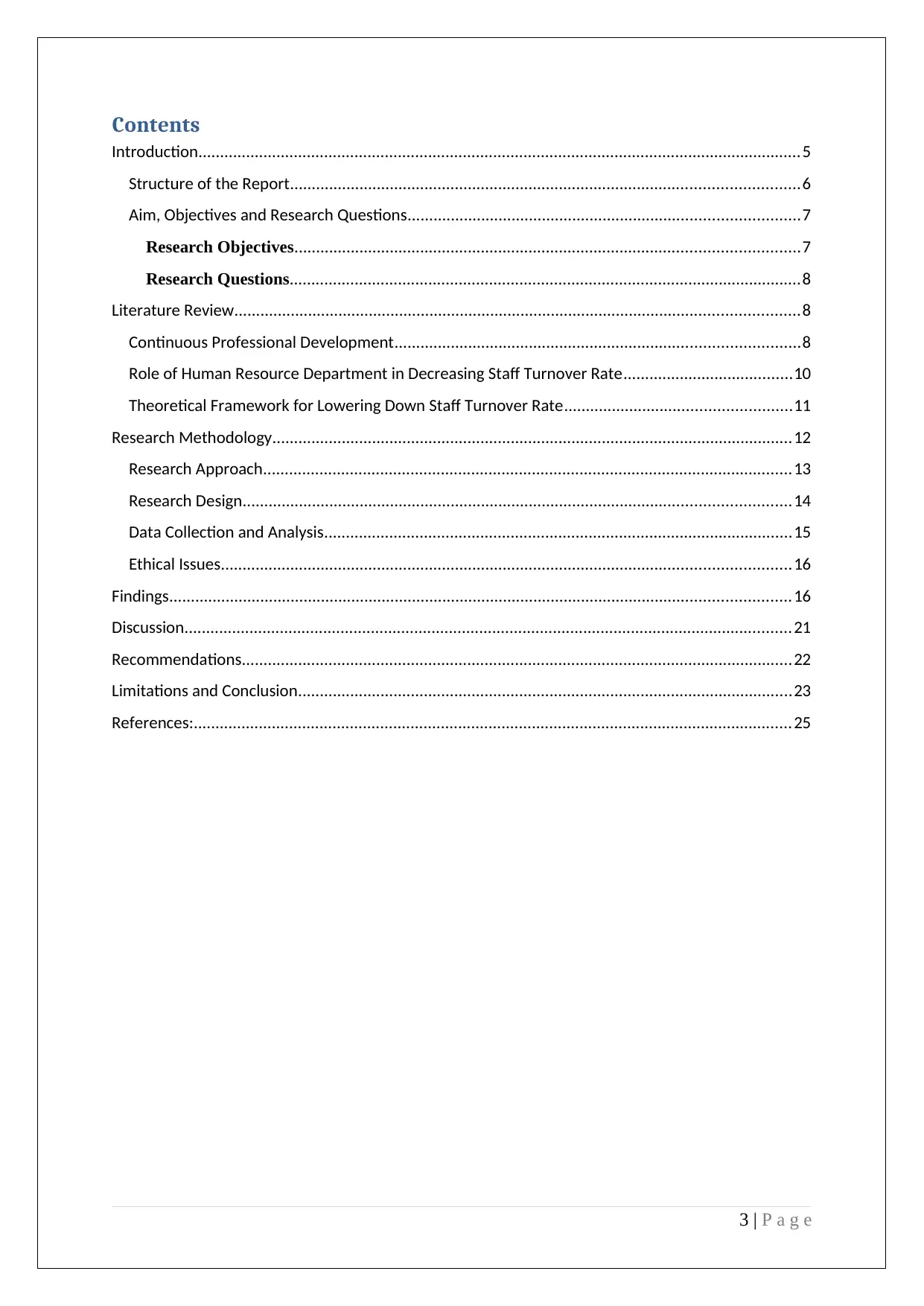
Contents
Introduction...........................................................................................................................................5
Structure of the Report.....................................................................................................................6
Aim, Objectives and Research Questions..........................................................................................7
Research Objectives....................................................................................................................7
Research Questions......................................................................................................................8
Literature Review..................................................................................................................................8
Continuous Professional Development.............................................................................................8
Role of Human Resource Department in Decreasing Staff Turnover Rate.......................................10
Theoretical Framework for Lowering Down Staff Turnover Rate....................................................11
Research Methodology........................................................................................................................12
Research Approach..........................................................................................................................13
Research Design..............................................................................................................................14
Data Collection and Analysis............................................................................................................15
Ethical Issues...................................................................................................................................16
Findings...............................................................................................................................................16
Discussion............................................................................................................................................21
Recommendations...............................................................................................................................22
Limitations and Conclusion..................................................................................................................23
References:..........................................................................................................................................25
3 | P a g e
Introduction...........................................................................................................................................5
Structure of the Report.....................................................................................................................6
Aim, Objectives and Research Questions..........................................................................................7
Research Objectives....................................................................................................................7
Research Questions......................................................................................................................8
Literature Review..................................................................................................................................8
Continuous Professional Development.............................................................................................8
Role of Human Resource Department in Decreasing Staff Turnover Rate.......................................10
Theoretical Framework for Lowering Down Staff Turnover Rate....................................................11
Research Methodology........................................................................................................................12
Research Approach..........................................................................................................................13
Research Design..............................................................................................................................14
Data Collection and Analysis............................................................................................................15
Ethical Issues...................................................................................................................................16
Findings...............................................................................................................................................16
Discussion............................................................................................................................................21
Recommendations...............................................................................................................................22
Limitations and Conclusion..................................................................................................................23
References:..........................................................................................................................................25
3 | P a g e
⊘ This is a preview!⊘
Do you want full access?
Subscribe today to unlock all pages.

Trusted by 1+ million students worldwide
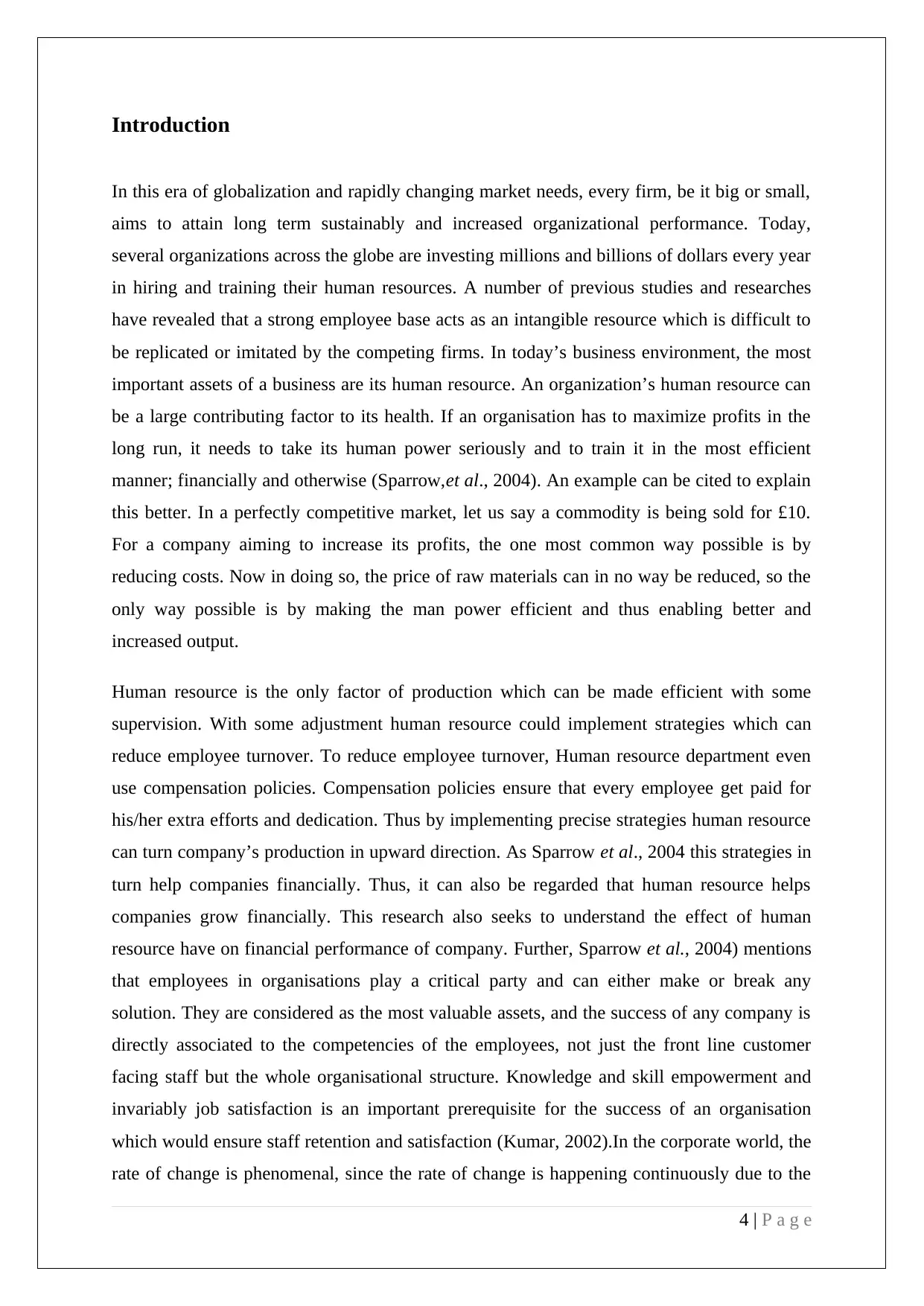
Introduction
In this era of globalization and rapidly changing market needs, every firm, be it big or small,
aims to attain long term sustainably and increased organizational performance. Today,
several organizations across the globe are investing millions and billions of dollars every year
in hiring and training their human resources. A number of previous studies and researches
have revealed that a strong employee base acts as an intangible resource which is difficult to
be replicated or imitated by the competing firms. In today’s business environment, the most
important assets of a business are its human resource. An organization’s human resource can
be a large contributing factor to its health. If an organisation has to maximize profits in the
long run, it needs to take its human power seriously and to train it in the most efficient
manner; financially and otherwise (Sparrow,et al., 2004). An example can be cited to explain
this better. In a perfectly competitive market, let us say a commodity is being sold for £10.
For a company aiming to increase its profits, the one most common way possible is by
reducing costs. Now in doing so, the price of raw materials can in no way be reduced, so the
only way possible is by making the man power efficient and thus enabling better and
increased output.
Human resource is the only factor of production which can be made efficient with some
supervision. With some adjustment human resource could implement strategies which can
reduce employee turnover. To reduce employee turnover, Human resource department even
use compensation policies. Compensation policies ensure that every employee get paid for
his/her extra efforts and dedication. Thus by implementing precise strategies human resource
can turn company’s production in upward direction. As Sparrow et al., 2004 this strategies in
turn help companies financially. Thus, it can also be regarded that human resource helps
companies grow financially. This research also seeks to understand the effect of human
resource have on financial performance of company. Further, Sparrow et al., 2004) mentions
that employees in organisations play a critical party and can either make or break any
solution. They are considered as the most valuable assets, and the success of any company is
directly associated to the competencies of the employees, not just the front line customer
facing staff but the whole organisational structure. Knowledge and skill empowerment and
invariably job satisfaction is an important prerequisite for the success of an organisation
which would ensure staff retention and satisfaction (Kumar, 2002).In the corporate world, the
rate of change is phenomenal, since the rate of change is happening continuously due to the
4 | P a g e
In this era of globalization and rapidly changing market needs, every firm, be it big or small,
aims to attain long term sustainably and increased organizational performance. Today,
several organizations across the globe are investing millions and billions of dollars every year
in hiring and training their human resources. A number of previous studies and researches
have revealed that a strong employee base acts as an intangible resource which is difficult to
be replicated or imitated by the competing firms. In today’s business environment, the most
important assets of a business are its human resource. An organization’s human resource can
be a large contributing factor to its health. If an organisation has to maximize profits in the
long run, it needs to take its human power seriously and to train it in the most efficient
manner; financially and otherwise (Sparrow,et al., 2004). An example can be cited to explain
this better. In a perfectly competitive market, let us say a commodity is being sold for £10.
For a company aiming to increase its profits, the one most common way possible is by
reducing costs. Now in doing so, the price of raw materials can in no way be reduced, so the
only way possible is by making the man power efficient and thus enabling better and
increased output.
Human resource is the only factor of production which can be made efficient with some
supervision. With some adjustment human resource could implement strategies which can
reduce employee turnover. To reduce employee turnover, Human resource department even
use compensation policies. Compensation policies ensure that every employee get paid for
his/her extra efforts and dedication. Thus by implementing precise strategies human resource
can turn company’s production in upward direction. As Sparrow et al., 2004 this strategies in
turn help companies financially. Thus, it can also be regarded that human resource helps
companies grow financially. This research also seeks to understand the effect of human
resource have on financial performance of company. Further, Sparrow et al., 2004) mentions
that employees in organisations play a critical party and can either make or break any
solution. They are considered as the most valuable assets, and the success of any company is
directly associated to the competencies of the employees, not just the front line customer
facing staff but the whole organisational structure. Knowledge and skill empowerment and
invariably job satisfaction is an important prerequisite for the success of an organisation
which would ensure staff retention and satisfaction (Kumar, 2002).In the corporate world, the
rate of change is phenomenal, since the rate of change is happening continuously due to the
4 | P a g e
Paraphrase This Document
Need a fresh take? Get an instant paraphrase of this document with our AI Paraphraser
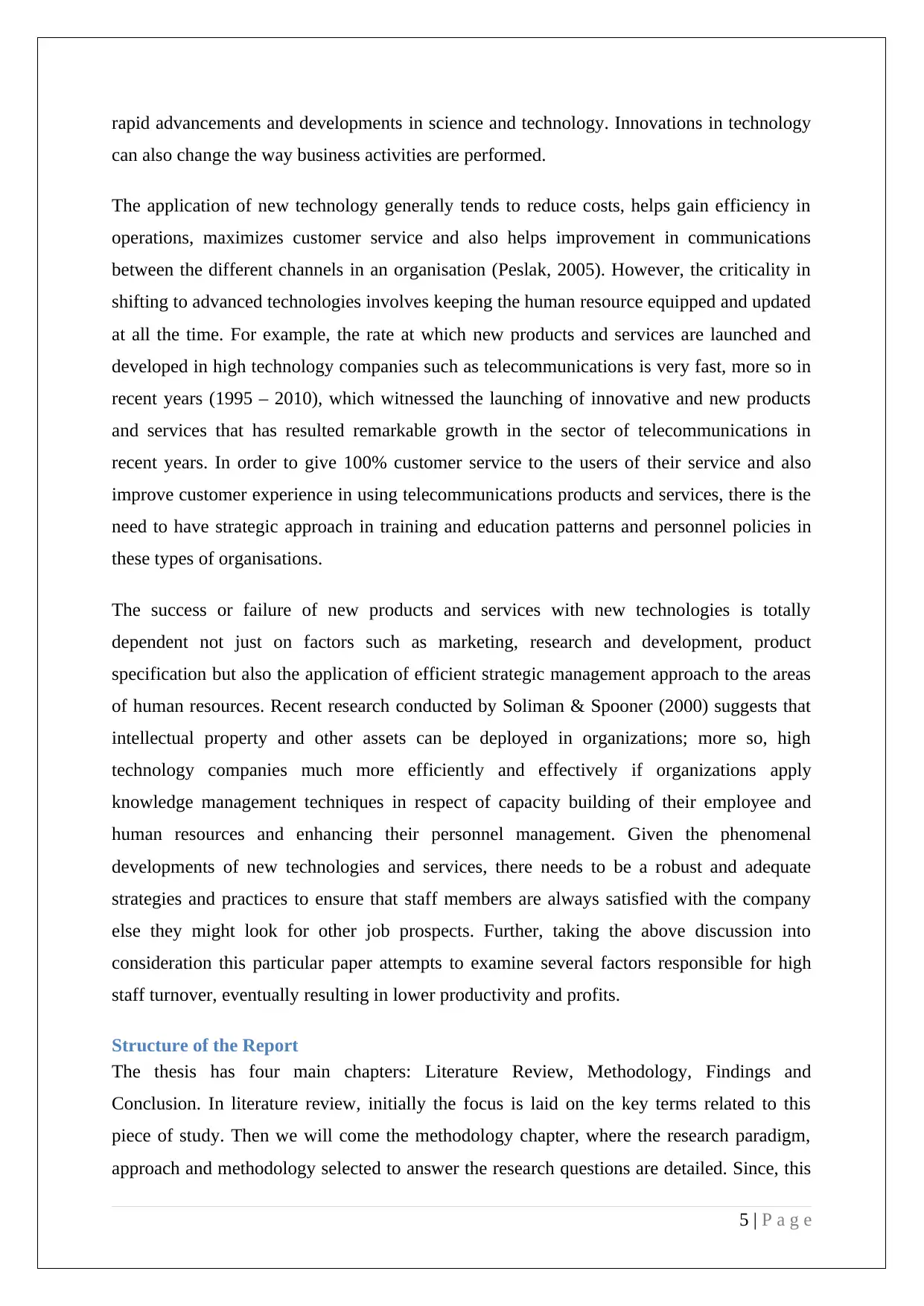
rapid advancements and developments in science and technology. Innovations in technology
can also change the way business activities are performed.
The application of new technology generally tends to reduce costs, helps gain efficiency in
operations, maximizes customer service and also helps improvement in communications
between the different channels in an organisation (Peslak, 2005). However, the criticality in
shifting to advanced technologies involves keeping the human resource equipped and updated
at all the time. For example, the rate at which new products and services are launched and
developed in high technology companies such as telecommunications is very fast, more so in
recent years (1995 – 2010), which witnessed the launching of innovative and new products
and services that has resulted remarkable growth in the sector of telecommunications in
recent years. In order to give 100% customer service to the users of their service and also
improve customer experience in using telecommunications products and services, there is the
need to have strategic approach in training and education patterns and personnel policies in
these types of organisations.
The success or failure of new products and services with new technologies is totally
dependent not just on factors such as marketing, research and development, product
specification but also the application of efficient strategic management approach to the areas
of human resources. Recent research conducted by Soliman & Spooner (2000) suggests that
intellectual property and other assets can be deployed in organizations; more so, high
technology companies much more efficiently and effectively if organizations apply
knowledge management techniques in respect of capacity building of their employee and
human resources and enhancing their personnel management. Given the phenomenal
developments of new technologies and services, there needs to be a robust and adequate
strategies and practices to ensure that staff members are always satisfied with the company
else they might look for other job prospects. Further, taking the above discussion into
consideration this particular paper attempts to examine several factors responsible for high
staff turnover, eventually resulting in lower productivity and profits.
Structure of the Report
The thesis has four main chapters: Literature Review, Methodology, Findings and
Conclusion. In literature review, initially the focus is laid on the key terms related to this
piece of study. Then we will come the methodology chapter, where the research paradigm,
approach and methodology selected to answer the research questions are detailed. Since, this
5 | P a g e
can also change the way business activities are performed.
The application of new technology generally tends to reduce costs, helps gain efficiency in
operations, maximizes customer service and also helps improvement in communications
between the different channels in an organisation (Peslak, 2005). However, the criticality in
shifting to advanced technologies involves keeping the human resource equipped and updated
at all the time. For example, the rate at which new products and services are launched and
developed in high technology companies such as telecommunications is very fast, more so in
recent years (1995 – 2010), which witnessed the launching of innovative and new products
and services that has resulted remarkable growth in the sector of telecommunications in
recent years. In order to give 100% customer service to the users of their service and also
improve customer experience in using telecommunications products and services, there is the
need to have strategic approach in training and education patterns and personnel policies in
these types of organisations.
The success or failure of new products and services with new technologies is totally
dependent not just on factors such as marketing, research and development, product
specification but also the application of efficient strategic management approach to the areas
of human resources. Recent research conducted by Soliman & Spooner (2000) suggests that
intellectual property and other assets can be deployed in organizations; more so, high
technology companies much more efficiently and effectively if organizations apply
knowledge management techniques in respect of capacity building of their employee and
human resources and enhancing their personnel management. Given the phenomenal
developments of new technologies and services, there needs to be a robust and adequate
strategies and practices to ensure that staff members are always satisfied with the company
else they might look for other job prospects. Further, taking the above discussion into
consideration this particular paper attempts to examine several factors responsible for high
staff turnover, eventually resulting in lower productivity and profits.
Structure of the Report
The thesis has four main chapters: Literature Review, Methodology, Findings and
Conclusion. In literature review, initially the focus is laid on the key terms related to this
piece of study. Then we will come the methodology chapter, where the research paradigm,
approach and methodology selected to answer the research questions are detailed. Since, this
5 | P a g e
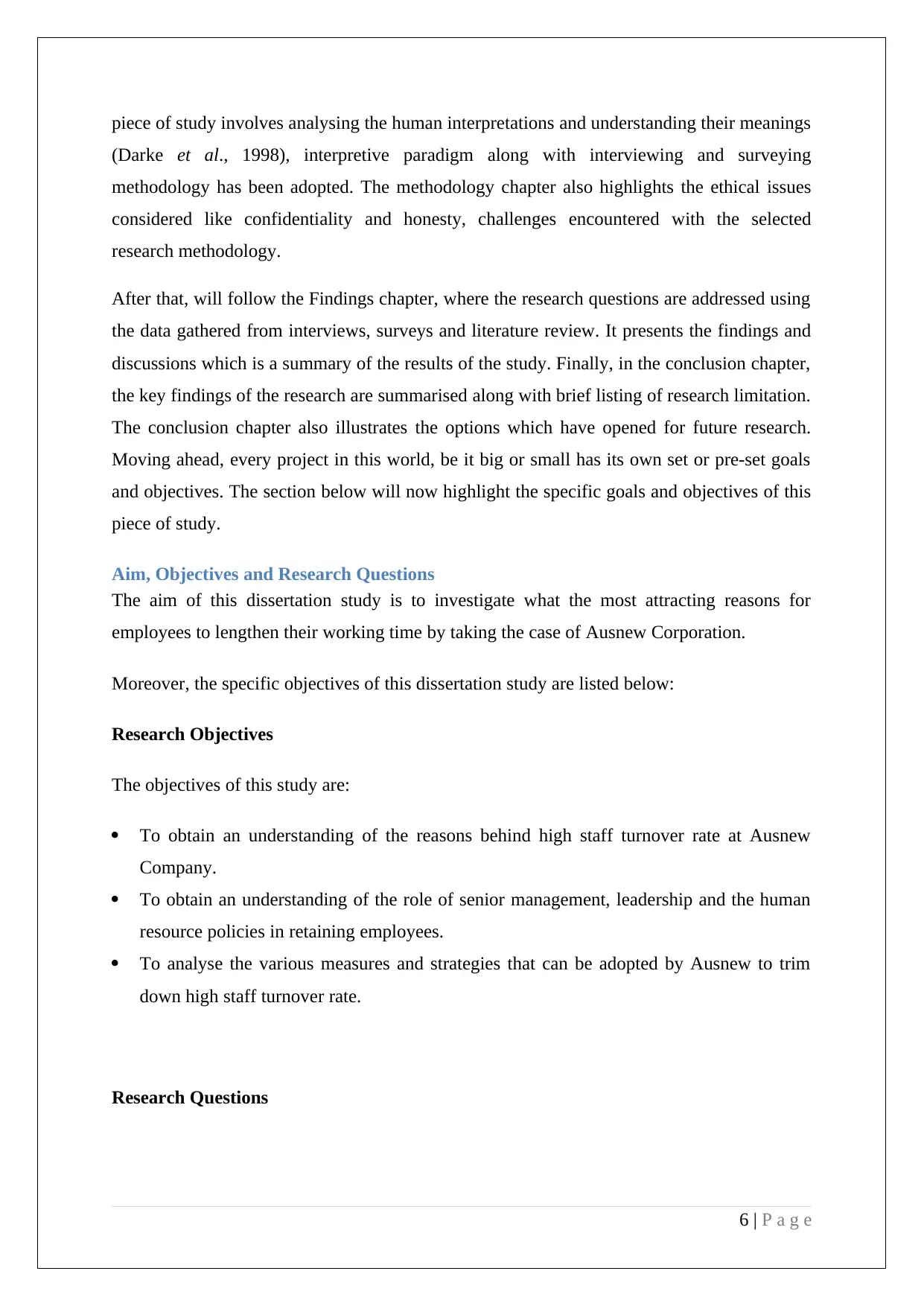
piece of study involves analysing the human interpretations and understanding their meanings
(Darke et al., 1998), interpretive paradigm along with interviewing and surveying
methodology has been adopted. The methodology chapter also highlights the ethical issues
considered like confidentiality and honesty, challenges encountered with the selected
research methodology.
After that, will follow the Findings chapter, where the research questions are addressed using
the data gathered from interviews, surveys and literature review. It presents the findings and
discussions which is a summary of the results of the study. Finally, in the conclusion chapter,
the key findings of the research are summarised along with brief listing of research limitation.
The conclusion chapter also illustrates the options which have opened for future research.
Moving ahead, every project in this world, be it big or small has its own set or pre-set goals
and objectives. The section below will now highlight the specific goals and objectives of this
piece of study.
Aim, Objectives and Research Questions
The aim of this dissertation study is to investigate what the most attracting reasons for
employees to lengthen their working time by taking the case of Ausnew Corporation.
Moreover, the specific objectives of this dissertation study are listed below:
Research Objectives
The objectives of this study are:
To obtain an understanding of the reasons behind high staff turnover rate at Ausnew
Company.
To obtain an understanding of the role of senior management, leadership and the human
resource policies in retaining employees.
To analyse the various measures and strategies that can be adopted by Ausnew to trim
down high staff turnover rate.
Research Questions
6 | P a g e
(Darke et al., 1998), interpretive paradigm along with interviewing and surveying
methodology has been adopted. The methodology chapter also highlights the ethical issues
considered like confidentiality and honesty, challenges encountered with the selected
research methodology.
After that, will follow the Findings chapter, where the research questions are addressed using
the data gathered from interviews, surveys and literature review. It presents the findings and
discussions which is a summary of the results of the study. Finally, in the conclusion chapter,
the key findings of the research are summarised along with brief listing of research limitation.
The conclusion chapter also illustrates the options which have opened for future research.
Moving ahead, every project in this world, be it big or small has its own set or pre-set goals
and objectives. The section below will now highlight the specific goals and objectives of this
piece of study.
Aim, Objectives and Research Questions
The aim of this dissertation study is to investigate what the most attracting reasons for
employees to lengthen their working time by taking the case of Ausnew Corporation.
Moreover, the specific objectives of this dissertation study are listed below:
Research Objectives
The objectives of this study are:
To obtain an understanding of the reasons behind high staff turnover rate at Ausnew
Company.
To obtain an understanding of the role of senior management, leadership and the human
resource policies in retaining employees.
To analyse the various measures and strategies that can be adopted by Ausnew to trim
down high staff turnover rate.
Research Questions
6 | P a g e
⊘ This is a preview!⊘
Do you want full access?
Subscribe today to unlock all pages.

Trusted by 1+ million students worldwide
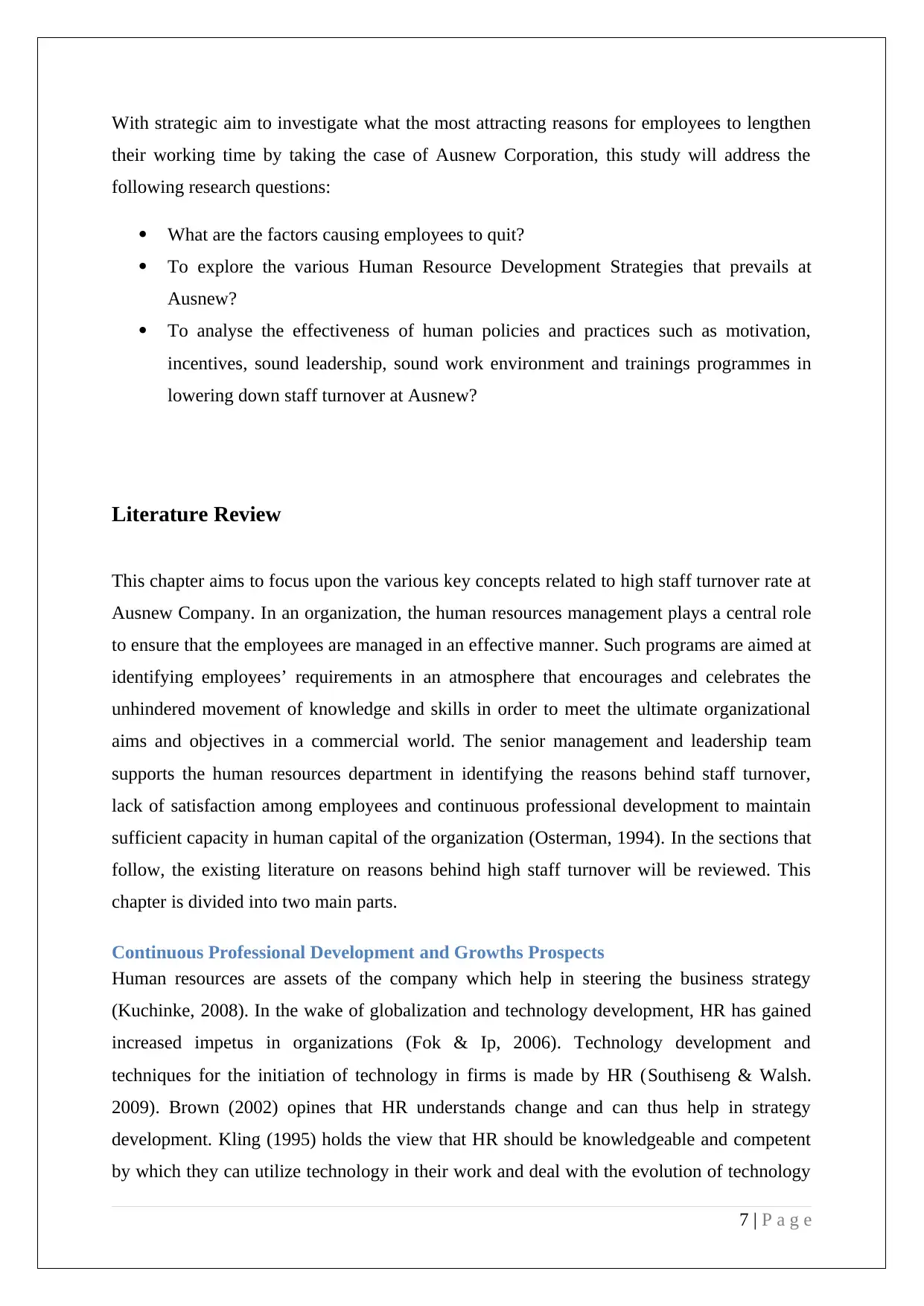
With strategic aim to investigate what the most attracting reasons for employees to lengthen
their working time by taking the case of Ausnew Corporation, this study will address the
following research questions:
What are the factors causing employees to quit?
To explore the various Human Resource Development Strategies that prevails at
Ausnew?
To analyse the effectiveness of human policies and practices such as motivation,
incentives, sound leadership, sound work environment and trainings programmes in
lowering down staff turnover at Ausnew?
Literature Review
This chapter aims to focus upon the various key concepts related to high staff turnover rate at
Ausnew Company. In an organization, the human resources management plays a central role
to ensure that the employees are managed in an effective manner. Such programs are aimed at
identifying employees’ requirements in an atmosphere that encourages and celebrates the
unhindered movement of knowledge and skills in order to meet the ultimate organizational
aims and objectives in a commercial world. The senior management and leadership team
supports the human resources department in identifying the reasons behind staff turnover,
lack of satisfaction among employees and continuous professional development to maintain
sufficient capacity in human capital of the organization (Osterman, 1994). In the sections that
follow, the existing literature on reasons behind high staff turnover will be reviewed. This
chapter is divided into two main parts.
Continuous Professional Development and Growths Prospects
Human resources are assets of the company which help in steering the business strategy
(Kuchinke, 2008). In the wake of globalization and technology development, HR has gained
increased impetus in organizations (Fok & Ip, 2006). Technology development and
techniques for the initiation of technology in firms is made by HR (Southiseng & Walsh.
2009). Brown (2002) opines that HR understands change and can thus help in strategy
development. Kling (1995) holds the view that HR should be knowledgeable and competent
by which they can utilize technology in their work and deal with the evolution of technology
7 | P a g e
their working time by taking the case of Ausnew Corporation, this study will address the
following research questions:
What are the factors causing employees to quit?
To explore the various Human Resource Development Strategies that prevails at
Ausnew?
To analyse the effectiveness of human policies and practices such as motivation,
incentives, sound leadership, sound work environment and trainings programmes in
lowering down staff turnover at Ausnew?
Literature Review
This chapter aims to focus upon the various key concepts related to high staff turnover rate at
Ausnew Company. In an organization, the human resources management plays a central role
to ensure that the employees are managed in an effective manner. Such programs are aimed at
identifying employees’ requirements in an atmosphere that encourages and celebrates the
unhindered movement of knowledge and skills in order to meet the ultimate organizational
aims and objectives in a commercial world. The senior management and leadership team
supports the human resources department in identifying the reasons behind staff turnover,
lack of satisfaction among employees and continuous professional development to maintain
sufficient capacity in human capital of the organization (Osterman, 1994). In the sections that
follow, the existing literature on reasons behind high staff turnover will be reviewed. This
chapter is divided into two main parts.
Continuous Professional Development and Growths Prospects
Human resources are assets of the company which help in steering the business strategy
(Kuchinke, 2008). In the wake of globalization and technology development, HR has gained
increased impetus in organizations (Fok & Ip, 2006). Technology development and
techniques for the initiation of technology in firms is made by HR (Southiseng & Walsh.
2009). Brown (2002) opines that HR understands change and can thus help in strategy
development. Kling (1995) holds the view that HR should be knowledgeable and competent
by which they can utilize technology in their work and deal with the evolution of technology
7 | P a g e
Paraphrase This Document
Need a fresh take? Get an instant paraphrase of this document with our AI Paraphraser
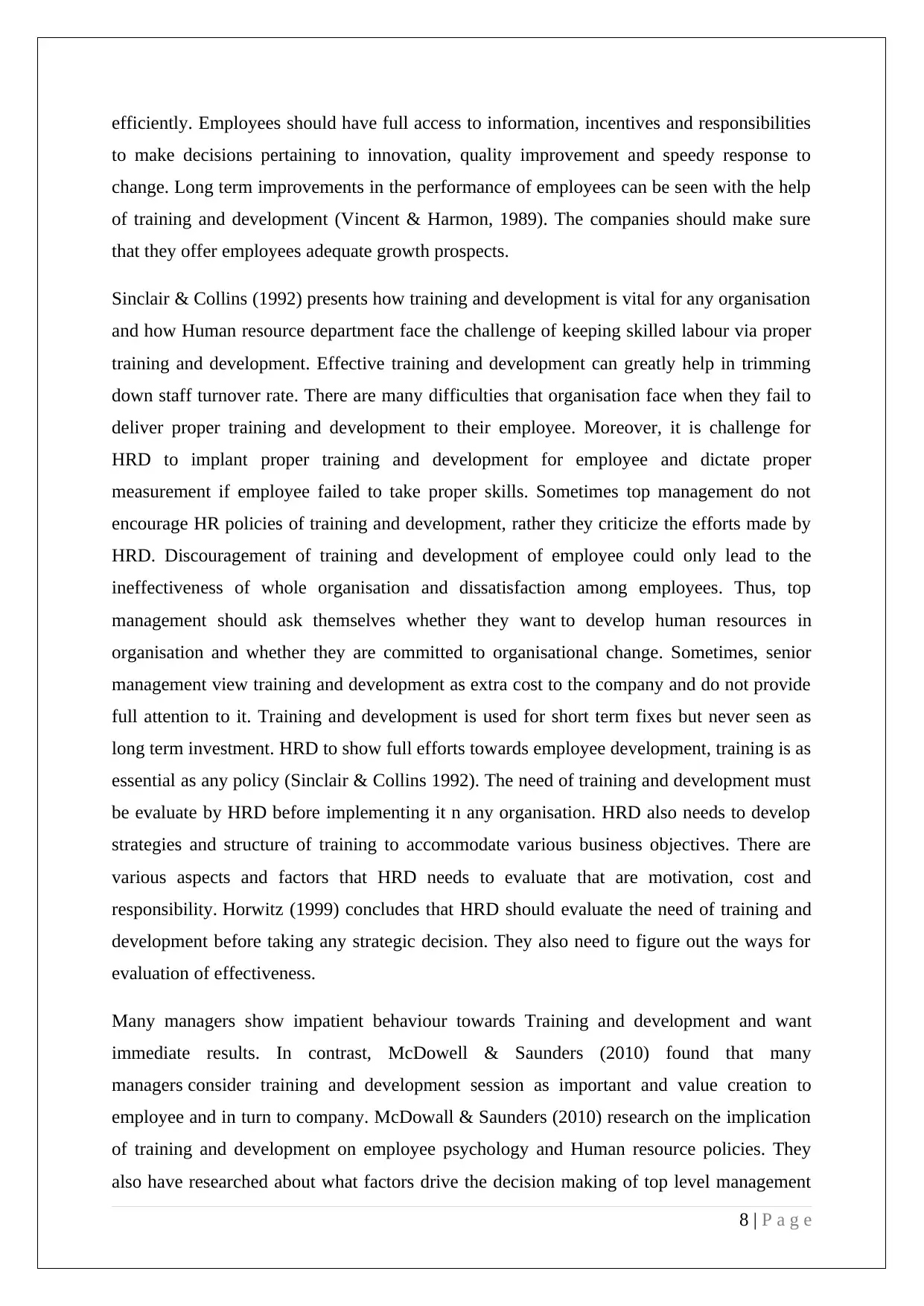
efficiently. Employees should have full access to information, incentives and responsibilities
to make decisions pertaining to innovation, quality improvement and speedy response to
change. Long term improvements in the performance of employees can be seen with the help
of training and development (Vincent & Harmon, 1989). The companies should make sure
that they offer employees adequate growth prospects.
Sinclair & Collins (1992) presents how training and development is vital for any organisation
and how Human resource department face the challenge of keeping skilled labour via proper
training and development. Effective training and development can greatly help in trimming
down staff turnover rate. There are many difficulties that organisation face when they fail to
deliver proper training and development to their employee. Moreover, it is challenge for
HRD to implant proper training and development for employee and dictate proper
measurement if employee failed to take proper skills. Sometimes top management do not
encourage HR policies of training and development, rather they criticize the efforts made by
HRD. Discouragement of training and development of employee could only lead to the
ineffectiveness of whole organisation and dissatisfaction among employees. Thus, top
management should ask themselves whether they want to develop human resources in
organisation and whether they are committed to organisational change. Sometimes, senior
management view training and development as extra cost to the company and do not provide
full attention to it. Training and development is used for short term fixes but never seen as
long term investment. HRD to show full efforts towards employee development, training is as
essential as any policy (Sinclair & Collins 1992). The need of training and development must
be evaluate by HRD before implementing it n any organisation. HRD also needs to develop
strategies and structure of training to accommodate various business objectives. There are
various aspects and factors that HRD needs to evaluate that are motivation, cost and
responsibility. Horwitz (1999) concludes that HRD should evaluate the need of training and
development before taking any strategic decision. They also need to figure out the ways for
evaluation of effectiveness.
Many managers show impatient behaviour towards Training and development and want
immediate results. In contrast, McDowell & Saunders (2010) found that many
managers consider training and development session as important and value creation to
employee and in turn to company. McDowall & Saunders (2010) research on the implication
of training and development on employee psychology and Human resource policies. They
also have researched about what factors drive the decision making of top level management
8 | P a g e
to make decisions pertaining to innovation, quality improvement and speedy response to
change. Long term improvements in the performance of employees can be seen with the help
of training and development (Vincent & Harmon, 1989). The companies should make sure
that they offer employees adequate growth prospects.
Sinclair & Collins (1992) presents how training and development is vital for any organisation
and how Human resource department face the challenge of keeping skilled labour via proper
training and development. Effective training and development can greatly help in trimming
down staff turnover rate. There are many difficulties that organisation face when they fail to
deliver proper training and development to their employee. Moreover, it is challenge for
HRD to implant proper training and development for employee and dictate proper
measurement if employee failed to take proper skills. Sometimes top management do not
encourage HR policies of training and development, rather they criticize the efforts made by
HRD. Discouragement of training and development of employee could only lead to the
ineffectiveness of whole organisation and dissatisfaction among employees. Thus, top
management should ask themselves whether they want to develop human resources in
organisation and whether they are committed to organisational change. Sometimes, senior
management view training and development as extra cost to the company and do not provide
full attention to it. Training and development is used for short term fixes but never seen as
long term investment. HRD to show full efforts towards employee development, training is as
essential as any policy (Sinclair & Collins 1992). The need of training and development must
be evaluate by HRD before implementing it n any organisation. HRD also needs to develop
strategies and structure of training to accommodate various business objectives. There are
various aspects and factors that HRD needs to evaluate that are motivation, cost and
responsibility. Horwitz (1999) concludes that HRD should evaluate the need of training and
development before taking any strategic decision. They also need to figure out the ways for
evaluation of effectiveness.
Many managers show impatient behaviour towards Training and development and want
immediate results. In contrast, McDowell & Saunders (2010) found that many
managers consider training and development session as important and value creation to
employee and in turn to company. McDowall & Saunders (2010) research on the implication
of training and development on employee psychology and Human resource policies. They
also have researched about what factors drive the decision making of top level management
8 | P a g e
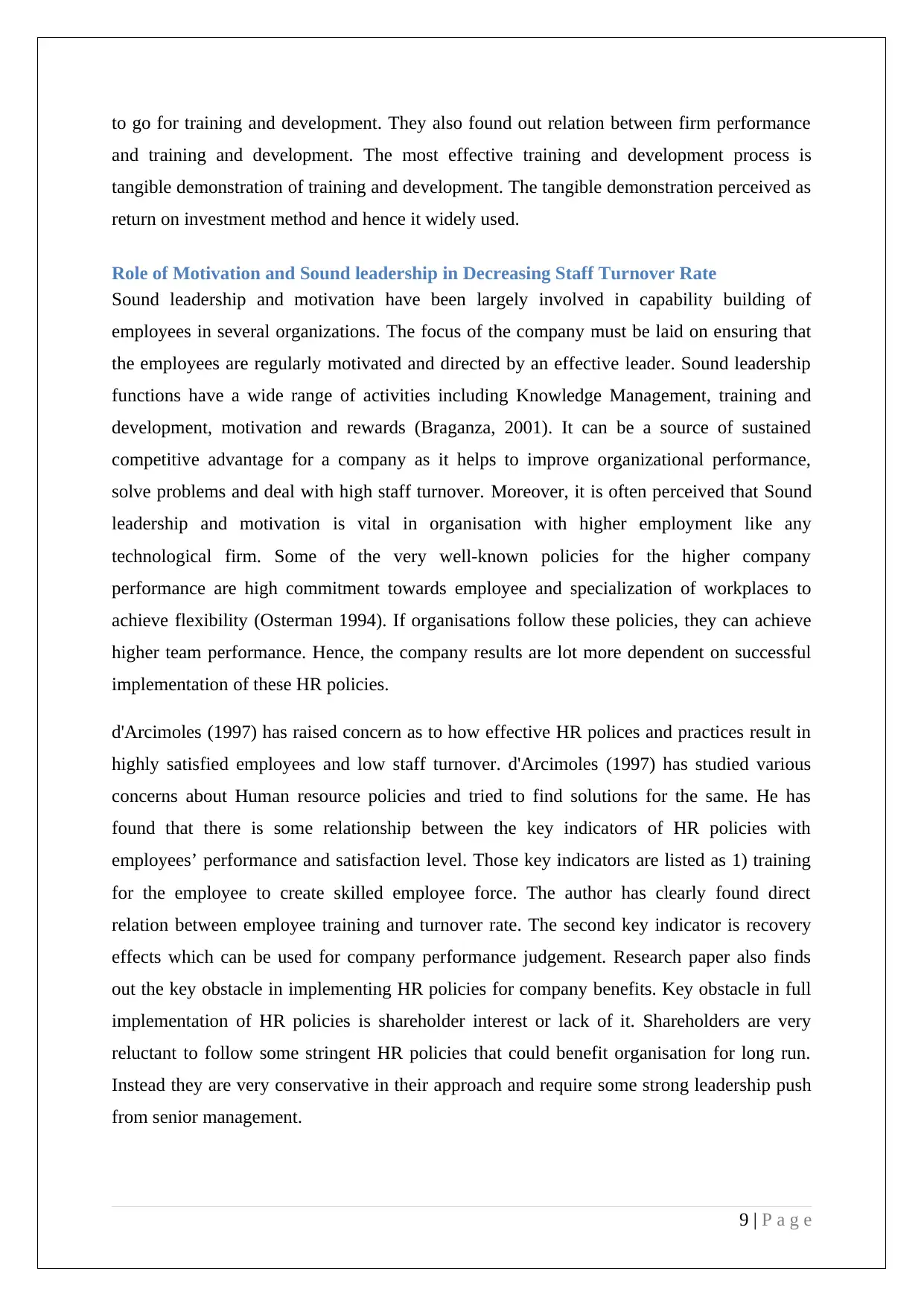
to go for training and development. They also found out relation between firm performance
and training and development. The most effective training and development process is
tangible demonstration of training and development. The tangible demonstration perceived as
return on investment method and hence it widely used.
Role of Motivation and Sound leadership in Decreasing Staff Turnover Rate
Sound leadership and motivation have been largely involved in capability building of
employees in several organizations. The focus of the company must be laid on ensuring that
the employees are regularly motivated and directed by an effective leader. Sound leadership
functions have a wide range of activities including Knowledge Management, training and
development, motivation and rewards (Braganza, 2001). It can be a source of sustained
competitive advantage for a company as it helps to improve organizational performance,
solve problems and deal with high staff turnover. Moreover, it is often perceived that Sound
leadership and motivation is vital in organisation with higher employment like any
technological firm. Some of the very well-known policies for the higher company
performance are high commitment towards employee and specialization of workplaces to
achieve flexibility (Osterman 1994). If organisations follow these policies, they can achieve
higher team performance. Hence, the company results are lot more dependent on successful
implementation of these HR policies.
d'Arcimoles (1997) has raised concern as to how effective HR polices and practices result in
highly satisfied employees and low staff turnover. d'Arcimoles (1997) has studied various
concerns about Human resource policies and tried to find solutions for the same. He has
found that there is some relationship between the key indicators of HR policies with
employees’ performance and satisfaction level. Those key indicators are listed as 1) training
for the employee to create skilled employee force. The author has clearly found direct
relation between employee training and turnover rate. The second key indicator is recovery
effects which can be used for company performance judgement. Research paper also finds
out the key obstacle in implementing HR policies for company benefits. Key obstacle in full
implementation of HR policies is shareholder interest or lack of it. Shareholders are very
reluctant to follow some stringent HR policies that could benefit organisation for long run.
Instead they are very conservative in their approach and require some strong leadership push
from senior management.
9 | P a g e
and training and development. The most effective training and development process is
tangible demonstration of training and development. The tangible demonstration perceived as
return on investment method and hence it widely used.
Role of Motivation and Sound leadership in Decreasing Staff Turnover Rate
Sound leadership and motivation have been largely involved in capability building of
employees in several organizations. The focus of the company must be laid on ensuring that
the employees are regularly motivated and directed by an effective leader. Sound leadership
functions have a wide range of activities including Knowledge Management, training and
development, motivation and rewards (Braganza, 2001). It can be a source of sustained
competitive advantage for a company as it helps to improve organizational performance,
solve problems and deal with high staff turnover. Moreover, it is often perceived that Sound
leadership and motivation is vital in organisation with higher employment like any
technological firm. Some of the very well-known policies for the higher company
performance are high commitment towards employee and specialization of workplaces to
achieve flexibility (Osterman 1994). If organisations follow these policies, they can achieve
higher team performance. Hence, the company results are lot more dependent on successful
implementation of these HR policies.
d'Arcimoles (1997) has raised concern as to how effective HR polices and practices result in
highly satisfied employees and low staff turnover. d'Arcimoles (1997) has studied various
concerns about Human resource policies and tried to find solutions for the same. He has
found that there is some relationship between the key indicators of HR policies with
employees’ performance and satisfaction level. Those key indicators are listed as 1) training
for the employee to create skilled employee force. The author has clearly found direct
relation between employee training and turnover rate. The second key indicator is recovery
effects which can be used for company performance judgement. Research paper also finds
out the key obstacle in implementing HR policies for company benefits. Key obstacle in full
implementation of HR policies is shareholder interest or lack of it. Shareholders are very
reluctant to follow some stringent HR policies that could benefit organisation for long run.
Instead they are very conservative in their approach and require some strong leadership push
from senior management.
9 | P a g e
⊘ This is a preview!⊘
Do you want full access?
Subscribe today to unlock all pages.

Trusted by 1+ million students worldwide
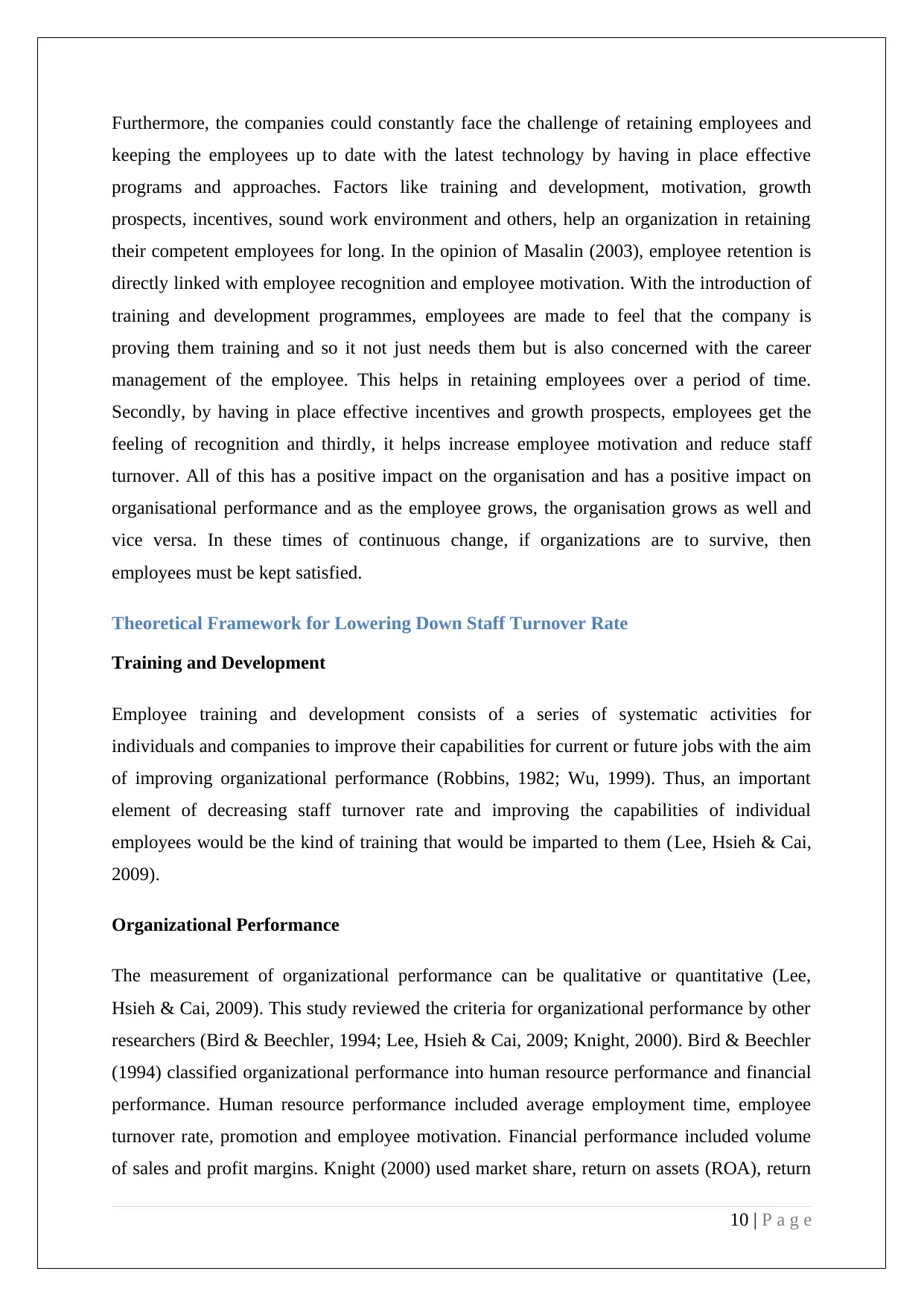
Furthermore, the companies could constantly face the challenge of retaining employees and
keeping the employees up to date with the latest technology by having in place effective
programs and approaches. Factors like training and development, motivation, growth
prospects, incentives, sound work environment and others, help an organization in retaining
their competent employees for long. In the opinion of Masalin (2003), employee retention is
directly linked with employee recognition and employee motivation. With the introduction of
training and development programmes, employees are made to feel that the company is
proving them training and so it not just needs them but is also concerned with the career
management of the employee. This helps in retaining employees over a period of time.
Secondly, by having in place effective incentives and growth prospects, employees get the
feeling of recognition and thirdly, it helps increase employee motivation and reduce staff
turnover. All of this has a positive impact on the organisation and has a positive impact on
organisational performance and as the employee grows, the organisation grows as well and
vice versa. In these times of continuous change, if organizations are to survive, then
employees must be kept satisfied.
Theoretical Framework for Lowering Down Staff Turnover Rate
Training and Development
Employee training and development consists of a series of systematic activities for
individuals and companies to improve their capabilities for current or future jobs with the aim
of improving organizational performance (Robbins, 1982; Wu, 1999). Thus, an important
element of decreasing staff turnover rate and improving the capabilities of individual
employees would be the kind of training that would be imparted to them (Lee, Hsieh & Cai,
2009).
Organizational Performance
The measurement of organizational performance can be qualitative or quantitative (Lee,
Hsieh & Cai, 2009). This study reviewed the criteria for organizational performance by other
researchers (Bird & Beechler, 1994; Lee, Hsieh & Cai, 2009; Knight, 2000). Bird & Beechler
(1994) classified organizational performance into human resource performance and financial
performance. Human resource performance included average employment time, employee
turnover rate, promotion and employee motivation. Financial performance included volume
of sales and profit margins. Knight (2000) used market share, return on assets (ROA), return
10 | P a g e
keeping the employees up to date with the latest technology by having in place effective
programs and approaches. Factors like training and development, motivation, growth
prospects, incentives, sound work environment and others, help an organization in retaining
their competent employees for long. In the opinion of Masalin (2003), employee retention is
directly linked with employee recognition and employee motivation. With the introduction of
training and development programmes, employees are made to feel that the company is
proving them training and so it not just needs them but is also concerned with the career
management of the employee. This helps in retaining employees over a period of time.
Secondly, by having in place effective incentives and growth prospects, employees get the
feeling of recognition and thirdly, it helps increase employee motivation and reduce staff
turnover. All of this has a positive impact on the organisation and has a positive impact on
organisational performance and as the employee grows, the organisation grows as well and
vice versa. In these times of continuous change, if organizations are to survive, then
employees must be kept satisfied.
Theoretical Framework for Lowering Down Staff Turnover Rate
Training and Development
Employee training and development consists of a series of systematic activities for
individuals and companies to improve their capabilities for current or future jobs with the aim
of improving organizational performance (Robbins, 1982; Wu, 1999). Thus, an important
element of decreasing staff turnover rate and improving the capabilities of individual
employees would be the kind of training that would be imparted to them (Lee, Hsieh & Cai,
2009).
Organizational Performance
The measurement of organizational performance can be qualitative or quantitative (Lee,
Hsieh & Cai, 2009). This study reviewed the criteria for organizational performance by other
researchers (Bird & Beechler, 1994; Lee, Hsieh & Cai, 2009; Knight, 2000). Bird & Beechler
(1994) classified organizational performance into human resource performance and financial
performance. Human resource performance included average employment time, employee
turnover rate, promotion and employee motivation. Financial performance included volume
of sales and profit margins. Knight (2000) used market share, return on assets (ROA), return
10 | P a g e
Paraphrase This Document
Need a fresh take? Get an instant paraphrase of this document with our AI Paraphraser
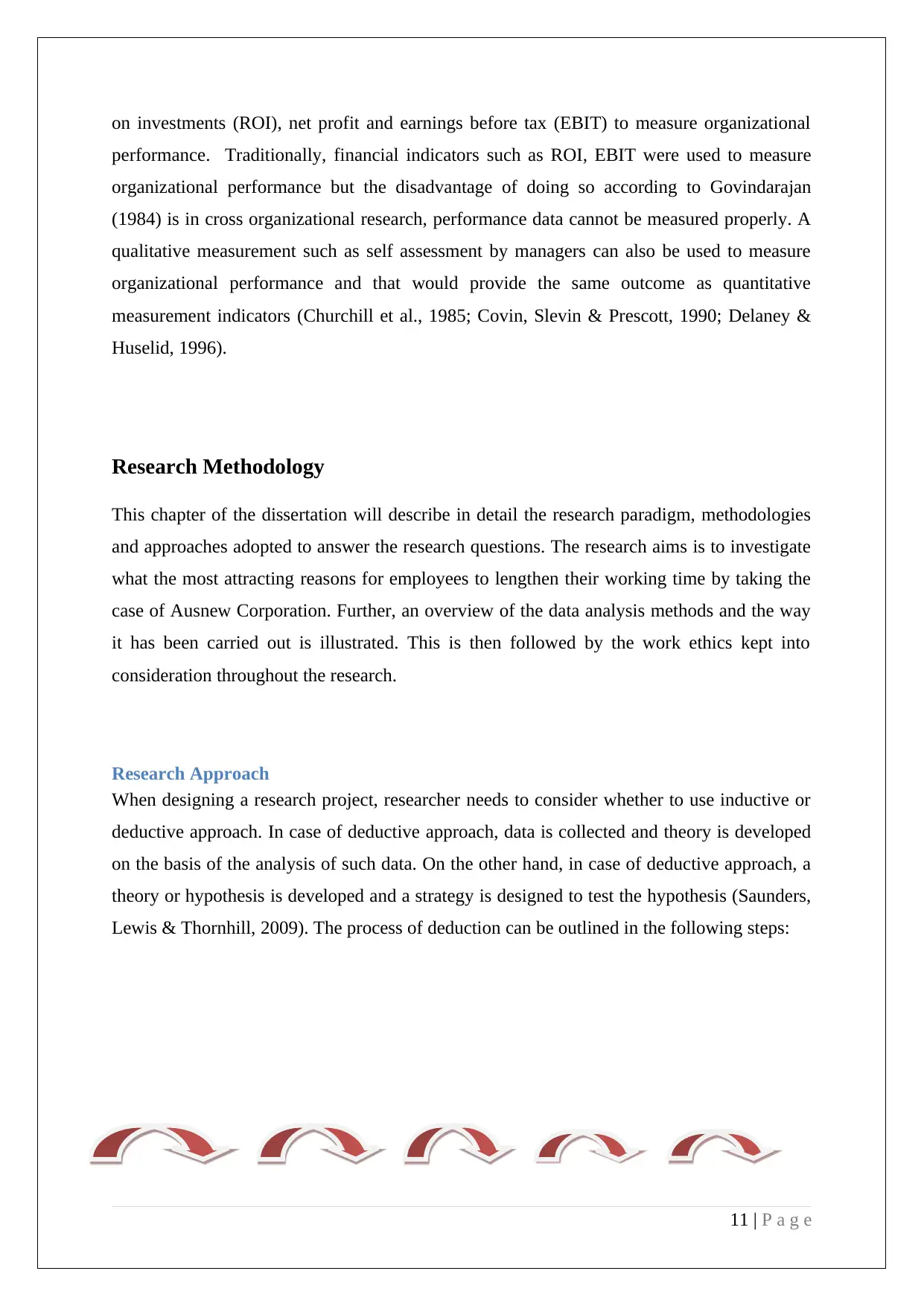
on investments (ROI), net profit and earnings before tax (EBIT) to measure organizational
performance. Traditionally, financial indicators such as ROI, EBIT were used to measure
organizational performance but the disadvantage of doing so according to Govindarajan
(1984) is in cross organizational research, performance data cannot be measured properly. A
qualitative measurement such as self assessment by managers can also be used to measure
organizational performance and that would provide the same outcome as quantitative
measurement indicators (Churchill et al., 1985; Covin, Slevin & Prescott, 1990; Delaney &
Huselid, 1996).
Research Methodology
This chapter of the dissertation will describe in detail the research paradigm, methodologies
and approaches adopted to answer the research questions. The research aims is to investigate
what the most attracting reasons for employees to lengthen their working time by taking the
case of Ausnew Corporation. Further, an overview of the data analysis methods and the way
it has been carried out is illustrated. This is then followed by the work ethics kept into
consideration throughout the research.
Research Approach
When designing a research project, researcher needs to consider whether to use inductive or
deductive approach. In case of deductive approach, data is collected and theory is developed
on the basis of the analysis of such data. On the other hand, in case of deductive approach, a
theory or hypothesis is developed and a strategy is designed to test the hypothesis (Saunders,
Lewis & Thornhill, 2009). The process of deduction can be outlined in the following steps:
11 | P a g e
performance. Traditionally, financial indicators such as ROI, EBIT were used to measure
organizational performance but the disadvantage of doing so according to Govindarajan
(1984) is in cross organizational research, performance data cannot be measured properly. A
qualitative measurement such as self assessment by managers can also be used to measure
organizational performance and that would provide the same outcome as quantitative
measurement indicators (Churchill et al., 1985; Covin, Slevin & Prescott, 1990; Delaney &
Huselid, 1996).
Research Methodology
This chapter of the dissertation will describe in detail the research paradigm, methodologies
and approaches adopted to answer the research questions. The research aims is to investigate
what the most attracting reasons for employees to lengthen their working time by taking the
case of Ausnew Corporation. Further, an overview of the data analysis methods and the way
it has been carried out is illustrated. This is then followed by the work ethics kept into
consideration throughout the research.
Research Approach
When designing a research project, researcher needs to consider whether to use inductive or
deductive approach. In case of deductive approach, data is collected and theory is developed
on the basis of the analysis of such data. On the other hand, in case of deductive approach, a
theory or hypothesis is developed and a strategy is designed to test the hypothesis (Saunders,
Lewis & Thornhill, 2009). The process of deduction can be outlined in the following steps:
11 | P a g e
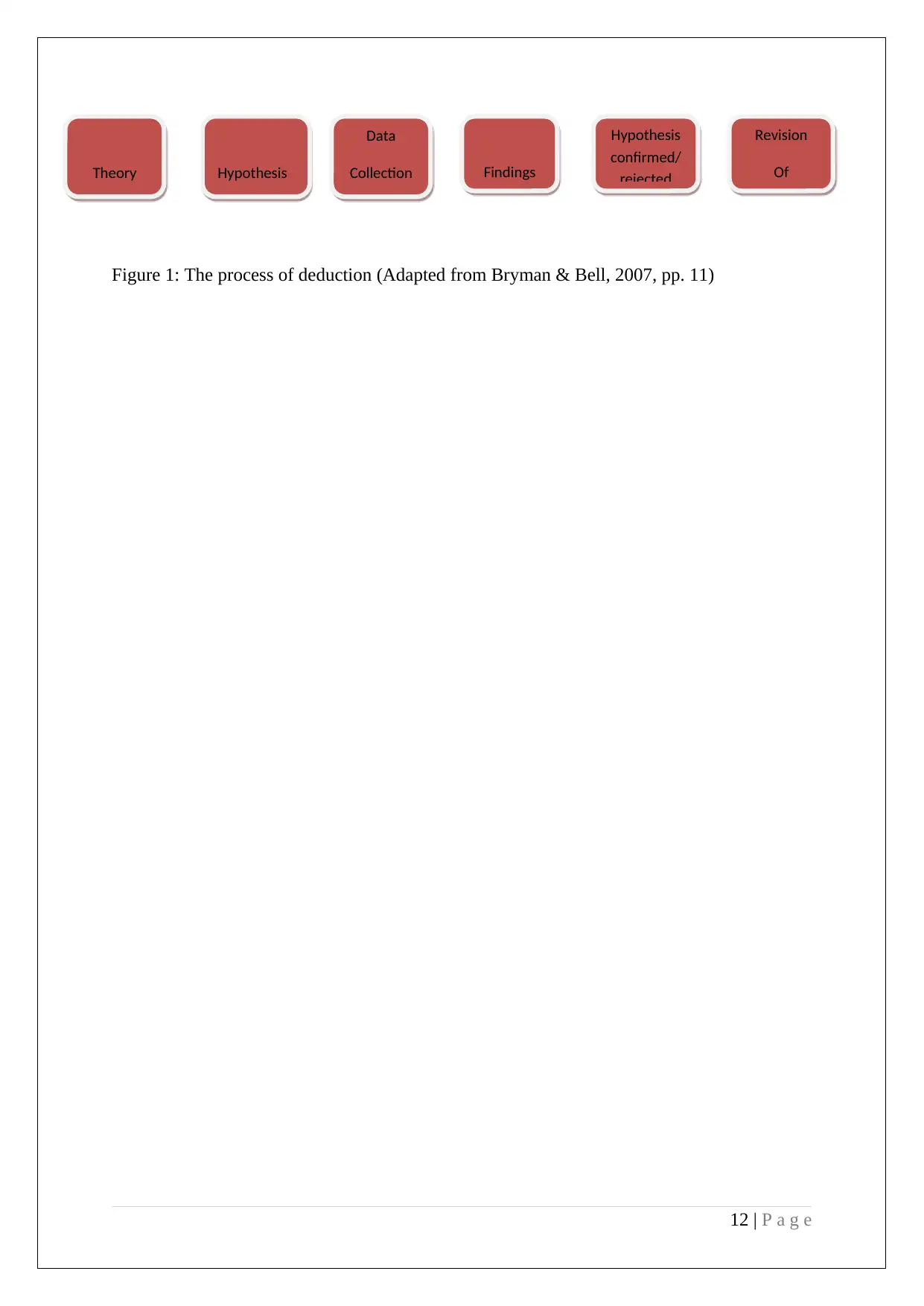
Figure 1: The process of deduction (Adapted from Bryman & Bell, 2007, pp. 11)
12 | P a g e
Theory Hypothesis
Data
Collection Findings
Hypothesis
confirmed/
rejected
Revision
Of
12 | P a g e
Theory Hypothesis
Data
Collection Findings
Hypothesis
confirmed/
rejected
Revision
Of
⊘ This is a preview!⊘
Do you want full access?
Subscribe today to unlock all pages.

Trusted by 1+ million students worldwide
1 out of 29
Related Documents
Your All-in-One AI-Powered Toolkit for Academic Success.
+13062052269
info@desklib.com
Available 24*7 on WhatsApp / Email
![[object Object]](/_next/static/media/star-bottom.7253800d.svg)
Unlock your academic potential
Copyright © 2020–2025 A2Z Services. All Rights Reserved. Developed and managed by ZUCOL.





